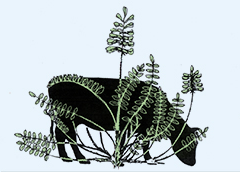Abstract
Learning from mother begins early in the developmental process and can have lifelong effects when it comes to foraging behavior. Pregnancy is not just an incubation period but a starting point for animal well-being and disease later in life. A better understanding of the effects that early exposure to unpalatable feeds impinges on their use later in life may help create management plans that utilize grazing animals to their full potential as landscape manipulators.
Thus, the objective of this research was to explore how experience in utero and early in life with sagebrush (Artemesia tridentata spp. tridentata) -a terpenoid-containing shrub- affected intake of and preference for sagebrush by sheep later in life. Eighty pregnant ewes (8 weeks of gestation) were divided into two groups, one group was exposed to sagebrush in their pens (25 to 30 Kg of freshly cut sagebrush was offered during 2-3 times a week), whereas the other group did not receive such exposure. Subsequently, lambs with their mothers were separated into four groups according to prior and subsequent exposure to sagebrush: 1) no exposure, 2) exposure in utero, 3) exposure in utero and for the first 2 mo. of life, and 4) exposure for the first 2 mo of life. At approximately 8 weeks of age, all lambs were weaned and four months later they were tested for their ability to ingest sagebrush. No differences regarding intake of sagebrush were detected among groups of lambs when they had choices between ad libitum amounts of alfalfa pellets and sagebrush (P > 0.10). When the amounts of alfalfa pellets in the choice test were restricted to 50% of ad libitum intake, lambs in the group that only had in utero experience with sagebrush (Group 2) showed the lowest intakes of sagebrush (P < 0.05). This suggests that in utero exposure to sagebrush decreased sagebrush preference and/or the ability of lambs to ingest this shrub. Sagebrush intake also increased across testing (P < 0.05), suggesting that exposure to sagebrush during testing had a more pronounced effect on sagebrush intake than in utero or early life experiences with the shrub. In conclusion, prior experience with sagebrush under the conditions of the present study did not reveal an enhancement in sagebrush use later in life by sheep; on the contrary, in utero experiences with the shrub appeared to have reduced the ability of lambs to ingest sagebrush. Results from this study also suggest that exposing young lambs for several days to sagebrush while restricting the availability of high-quality forage is a viable option that may enhance utilization of sagebrush.
Recommended Citation
Villalba, Juan J.; Provenza, Fred; and Longmore, Ashley
(2018)
"Does Experience With Sagebrush in Utero and Early in Life Influence Use of Sagebrush by sheep?,"
Poisonous Plant Research (PPR): Vol. 1, p. 14-25.
DOI: https://doi.org/10.26077/m28j-xb22
Available at:
https://digitalcommons.usu.edu/poisonousplantresearch/vol1/iss1/2

